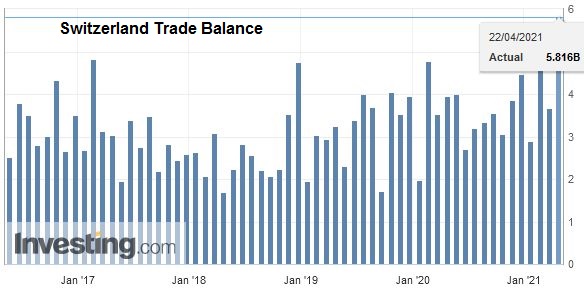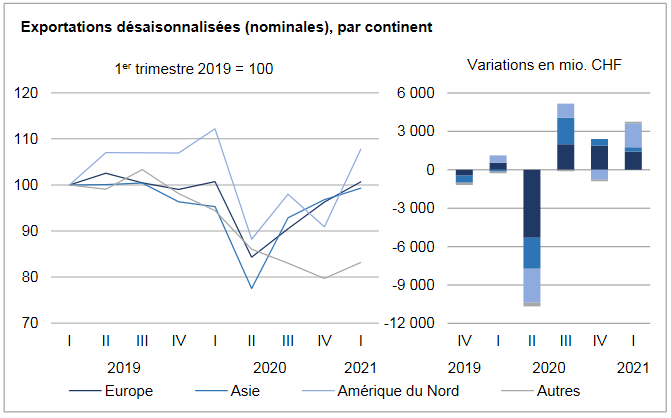We do not like Purchasing Power or Real Effective Exchange Rate (REER) as measurement for currencies. For us, the trade balance decides if a currency is overvalued. Only the trade balance can express productivity gains, while the REER assumes constant productivity in comparison to trade partners.
Who has read Michael Pettis, knows that a rising trade surplus may also be caused by a higher savings rate while the trade partners decided to spend more. This is partially true. Recently Europeans started to increase their savings rate, while Americans reduced it. This has led to a rising trade and current surplus for the Europeans. But also to a massive Swiss trade surplus with the United States, that lifted Switzerland on the U.S. currency manipulation watch list.
To control the trade balance against this “savings effect”, economists may look at imports. When imports are rising at the same pace as GDP or consumption, then there is no such “savings effect”.
After the record trade surpluses, the Swiss economy may have turned around: consumption and imports are finally rising more than in 2015 and early 2016. In March the trade surplus got bigger again, still shy of the records in 2016.
Swiss National Bank wants to keep non-profitable sectors alive
Swiss exports are moving more and more toward higher value sectors: away from watches, jewelry and manufacturing towards chemicals and pharmaceuticals. With currency interventions, the SNB is trying to keep sectors alive, that would not survive without interventions.
At the same time, importers keep the currency gains of imported goods and return little to the consumer. This tendency is accentuated by the SNB, that makes the franc weaker.
Texts and Charts from the Swiss customs data release (translated from French).
| Exports continued their recovery in Q1 2021 with growth of 4.8%. On the rise for the third consecutive quarter, they have thus passed above their pre-pandemic level. Imports, for their part, increased by 1.7% compared to the last quarter of 2020. However, they were found to be lower by 3.8 billion francs at their level for the 4th quarter of 2019. The trade balance closes with a surplus of 11.3 billion francs.
In short ▲ Exports: machinery and electronics as well as metals continue to grow ▲ Watch exports: solid quarterly result ▲ Record exports to China ∨ Imports of passenger cars: -607 million francs |
Swiss exports and imports, seasonally adjusted (in bn CHF), Q1 2021 Source: newsd.admin.ch - Click to enlarge |
Global evolutionDuring the 1st quarter of 2021 and on a seasonally adjusted basis, exports increased by 4.8% (+ 2.7 billion francs; actual: + 4.9%), signing a third consecutive quarterly increase. At 58.1 billion francs, they not only exceeded their pre-crisis level, but also their second largest quarterly result. Imports increased by 1.7% or 805 million francs (actual: + 1.9%). However, they have stagnated since the 3rd quarter of 2020 and are still killing 3.8 billion francs below their level of the last quarter of 2019. The trade balance is buckling with a record quarterly surplus of 11.3 billion francs. |
Switzerland Trade Balance, March 2021(see more posts on Switzerland Trade Balance, ) Source: investing.com - Click to enlarge |
Second highest level for exportsThe export boom has been based mainly on four sectors; all have also recovered to their pre-crisis level. More than half of the growth was driven by chemicals and pharmaceuticals (+1.4 billion francs). Here, all segments grew, drugs in the lead (+1.2 billion francs). Exports of the machinery and electronics sector (+ 5.8%; +422 million) as well as those of metals (+ 9.3%; +299 million) continued to grow in the 1st quarter of 2021. Watch sales are also shined (+ 4.0% or +206 million); With a turnover of 5.3 billion francs, they are thus close to their quarterly performance for the years 2018/19. The vehicle sector has retreated (-8.2%), after having however been a hit the two previous quarters. In the first quarter of 2021, Swiss exports increased to all the main markets. Those to North America took the lift (+ 18.5%; chemistry-pharma). Sales in the USA swelled by 2.0 billion francs – or a fifth – to flirt with their record level of the 1st quarter of 2020. Towards Europe, they grew by 4.6% (+1.4 billion francs ) to 32.6 billion francs, thus exceeding their pre-crisis level. France and Spain gained a tenth against 7.5% for Germany. This trio alone explained 90% of the boom with the Old Continent. Shipments to Asia were up 2.6% (+338 million) which was broadly supported. China (+ 9.4%; + 372 million) stood out, posting a record level of 4.3 billion francs. |
Swiss Exports per Sector Q1 2021 vs. 2020 |
Imports: dynamism with neighboring countriesTwo thirds of the commodity groups saw their imports strengthen during the first quarter of 2021. The metals (+ 9.8%), jewelry and jewelry (+ 8.3%), machinery and electronics (+ 7.7%) sectors have the most Supported growth, representing a cumulative increase of 1.2 billion francs. The last mentioned crossed, for the first time since the second quarter of 2019, the mark of 8 billion francs. Imports of vehicles (-13.4%; passenger cars: -607 million francs) and chemicals and pharmaceuticals (-1.0%), on the other hand, fell. In the latter, the decline in active ingredients as well as immunological products contrasted with the rise in drugs. Imports from Asia (+ 2.2%) and Europe (+ 1.2%) gained ground while those from North America showed their fourth decline in five quarters (-2.8%). On the Asian side, Singapore, the United Arab Emirates and China shone, accumulating a total increase of 770 million francs. The first has also raised a record level. After hitting bottom in the second quarter of 2020, arrivals from Europes have since been trending positively. In the 1st quarter of 2021, Germany made the strongest contribution to growth (+668 million francs). France, Spain, Italy and Austria were not to be outdone, this quartet generating an increase of 436 million francs. |
Swiss Imports per Sector Q1 2021 vs. 2020 |
Tags: Featured,newsletter,Switzerland Exports,Switzerland Exports by Sector,Switzerland Imports,Switzerland Imports by Sector,Switzerland Trade Balance


























